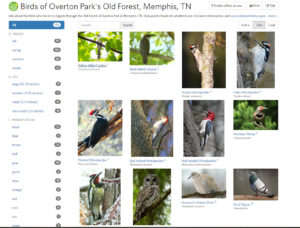New! Field guide to birds of the Old Forest
 The Old Forest is home to dozens of resident bird species, like the familiar Northern cardinal, American robin, and blue jay. But what about all the less-common birds that live here year-round, or the colorful warblers that pass through only during migration season? How do you identify those?
The Old Forest is home to dozens of resident bird species, like the familiar Northern cardinal, American robin, and blue jay. But what about all the less-common birds that live here year-round, or the colorful warblers that pass through only during migration season? How do you identify those?
Thanks to the iNaturalist platform, we’re bringing you a searchable guide to the birds of the Old Forest–both the residents and the migrants. It’s the same functionality that powers our field guide to plants, which means you can search and sort based on qualities like season, size, and color.
Because birds are complex creatures, there are a number of possible data points you can search. We’ve placed the ones we find most important at the top of the menu: the season they can be found in Overton Park, their general size, and the primary colors you would notice when looking at them. For example, if you’re looking for a small yellow bird that you’ve seen in the springtime:
- Click the “spring” row under “A-Present.” This narrows it down to only birds here in the spring.
- Hover over “small (5-9 inches)” under “B-Size” until a green plus sign appears. Click that plus sign.
- Finally, hover over “yellow” under “C-Primary Colors” and click the green plus sign that appears. You’ve just narrowed your search to twelve birds!
Here’s a rundown of all the keywords you can search. Just keep clicking the green plus signs beside the appropriate rows, and you’ll continue to narrow your search each time. To remove a category, hover over the row you’ve selected until a gray X appears, and click that X.
- Present: which season(s) the bird is present in Overton Park
- Size: the general size of an adult bird
- Primary Colors: the major color(s) you’d notice when observing a bird
- Breeds Here: whether you can expect to see baby birds of this species!
- Underparts: the dominant colors on the underside of the bird
- Upperparts: the dominant colors on the upper side of the bird
- Back Pattern: markings on the back of the bird
- Belly Pattern: markings on the belly
- Breast Pattern: markings on the breast
- Bill Shape: general shape of the bill or beak
- Eye Color: usually eye color of the adult bird
- Head Pattern: markings that describe one or more features of the entire head
- Crown Color: color of the very top of the head
- Forehead Color: color of the front of the head
- Nape Color: color of the back of the neck
- Throat Color: color of the front of the neck
- Wing Shape: shape of wings in flight
- Tail Shape
- Upper Tail Color
- Under Tail Color
- Leg Color
Hint: if you want to see, for example, what an “eyebrow” refers to, scroll down to “L-Head Pattern,” click “eyebrow,” and check out the birds that appear. They all have a pretty clear marking just above their eyes. (Or check out this diagram of the field marks of a bird.)
You can use this guide at home or in the field. If you’re on a mobile device, visit the App Store on your phone and download the free iNaturalist app. Once it’s installed, tap the menu icon and choose “Guides.” If you’re here in Tennessee, you can tap “Nearby” and our guide should automatically pop up in a list. If it doesn’t auto-populate, type “Overton Park” in the “Search Guides” box. Once you’ve loaded the guide, you can browse the entries, or tap the menu bar to sort by tags.
And remember–if you take a photo of a bird, upload that photo into the iNaturalist app and contribute to Overton Park’s observation list!
Want to learn more about birds, including their full range, audio of their songs, and fun facts? We recommend the Cornell Lab of Ornithology’s All About Birds site. Another site worth checking out is WhatBird.com, where we checked many of our data points.



